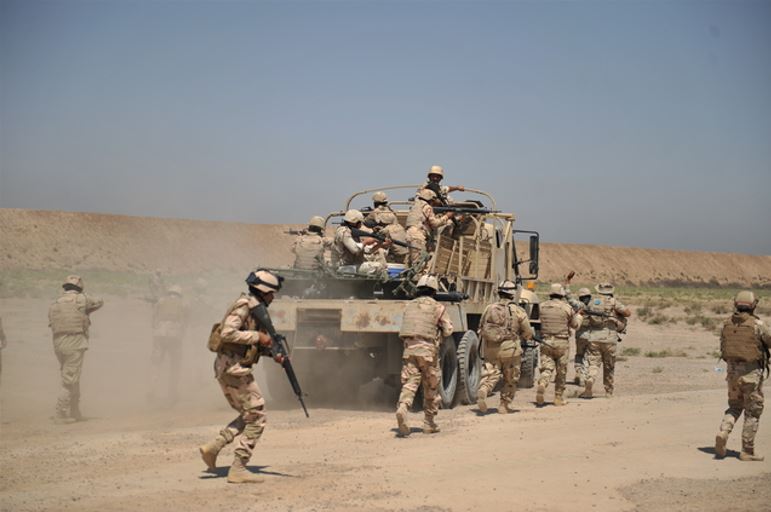 Print This Post
Print This Post- The Strategist - https://www.aspistrategist.org.au -
ASPI’s decades: Exiting Iraq
Posted By Graeme Dobell on September 1, 2021 @ 11:00

So far, broadly speaking, we’ve seen Iraq as the US’s game; so the most likely exit point has been one virtually of Washington’s choosing. If we want to move to a more ‘independent’ sense of our exit point, then our exit point logically depends on us reaching one of two decisions about the conditions in Iraq:
– either we judge that we have achieved what we wanted out of our engagement or
– we judge that what we wanted is no longer attainable at a sensible price.
Australia is involved in the early stages of a conflict that may last for the rest of the century and potentially beyond. Terrorism is but a symptom of a broader conflict in which the fundamental threat is from radical Islamists who are intent on establishing Islam as the foundation of a new world order. It’s a conflict between radical Islamists and modern secular, mostly Western, states. The likely duration of the conflict is due to the intrinsic and widespread appeal of the underlying ideology, the youth of those currently involved, their fervour and the inability of those under attack to either realise or accept the true nature of the threat. While the violence, so far, is mostly confined to Islamic lands, some of the radicals are engaged in a direct war against Western secular nations.
Ultimately, Australia and other Western countries have to come to terms with their limited role in shaping the outcomes of the battle for hegemony in the Arab Middle East. This doesn’t mean that there’s nothing to be done, but those outside the region must clinically and dispassionately consider their interests in the region and what they can reasonably expect to achieve.
In the process of liberating Mosul, coalition airpower delivered more than 5,075 weapons in support of ISF over the month of August 2017 alone. That’s an average of one aerially delivered weapon every 10 minutes. A total of 98,532 weapons have been delivered in Operation Inherent Resolve, in Syria and Iraq. For a force estimated to consist of around 30,000 fighters in 2015, that is both frighteningly inefficient and has devastated Iraq’s Sunni and Turkomen populations. The current short-term focus on the military defeat of IS belies the reality that Iraq will retain fragile governance, making it vulnerable to violent extremism.
The US toppled Saddam Hussein’s regime, but in the process also dismantled the administrative and security structures which were pivotal to holding the mosaic that was Iraq together as a functioning state. It ultimately failed to empower the Iraqi people to rebuild their lives and country and engaged in processes geared to benefit Washington’s ideological and geopolitical preferences rather than to endow Iraq with the appropriate foundations for stability and security in a very difficult neighbourhood.
The result was political, social and sectarian fragmentation, and transformation of the country from a strong state with suppressed societies to a weak state with strong societies. This opened the space for a plethora of not only domestic clusters but also outside forces to engage in power struggles to shape Iraq’s future.
Article printed from The Strategist: https://www.aspistrategist.org.au
URL to article: https://www.aspistrategist.org.au/aspis-decades-exiting-iraq/
[1] Rod Lyon wrote: https://s3-ap-southeast-2.amazonaws.com/ad-aspi/import/Policy_analysis3.pdf?tpI472lziyUi45toQLADLROXwPprFVQw
[2] in flux and at worst in turmoil: https://s3-ap-southeast-2.amazonaws.com/ad-aspi/import/SI64_MiddleEast.pdf?aFYWFXJIKoOEuolS5x9uGxjIq7W5bFMR
[3] caliphate: https://s3-ap-southeast-2.amazonaws.com/ad-aspi/import/Strategy_Strike_from_the_air.pdf?.4T2H2dOCxSysko49_AAY7Ey7h3FaL6T
[4] long war of the 21st century: https://s3-ap-southeast-2.amazonaws.com/ad-aspi/import/SI75_another_century_another_long_war.pdf?nyQzzSelVUMm2O14LpKqVL6v1UdMqEml
[5] Sunni Arab world: https://s3-ap-southeast-2.amazonaws.com/ad-aspi/2017-08/SR106_Middle%20East%20hegemony.pdf?.sXV5cgswzDLDY7cvoE3uSdIcKmseNTG
[6] strategic ambiguity: https://www.aspistrategist.org.au/the-war-in-iraq-tactical-success-strategic-ambiguity/
[7] Operation Inherent Resolve: http://www.afcent.af.mil/Portals/82/Documents/Airpower%20summary/Airpower%20Summary%20-%20August%202017.pdf?ver=2017-09-07-104037-223
[8] client state: https://www.aspistrategist.org.au/iraq-client-state-iran/
[9] peace and conflict: https://www.aspistrategist.org.au/iraqs-security-sector-faces-serious-challenges/
[10] An informed and independent voice: ASPI, 2001–2021: https://www.aspi.org.au/report/informed-and-independent-voice-aspi-2001-2021